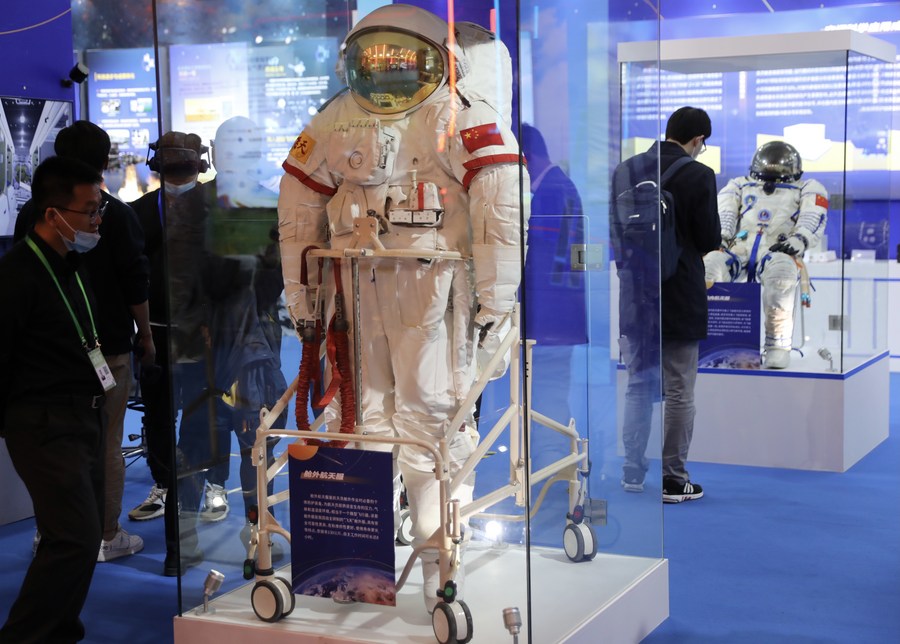Factbox: China's sci-tech achievements in 13th Five-Year Plan period

Space suits are on display at an exhibition on China's major scientific accomplishments during the 13th Five-Year Plan period (2016-2020) in Beijing, capital of China, Oct. 21, 2021. (Xinhua/Jin Liwang)
BEIJING, Nov. 2 (Xinhua) -- China has made great achievements in scientific and technological innovation during the 13th Five-Year Plan period (2016-2020).
As China embarks on a new journey to build a modern socialist country in all respects, sci-tech innovation will play a vital role in promoting the country's overall development.
According to the Global Innovation Index released by the World Intellectual Property Organization, China moved up from 29th place in 2015 to 12th this year in the world ranking.
The following are facts and figures reflecting the progress of the country's sci-tech fields.
CUTTING-EDGE SCI-TECH PROGRESS
-- In December 2020, researchers established the quantum computer prototype "Jiuzhang" through which up to 76 photons were detected, achieving quantum computational advantage. This achievement marks that China has reached the first milestone on the path to full-scale quantum computing -- a quantum computational advantage, also known as "quantum supremacy," which indicates an overwhelming quantum computational speedup.
-- China launched the second comprehensive scientific expedition to the Qinghai-Tibet Plateau in June 2017, 40 years after the first expedition. Lasting five to ten years, the expedition members will conduct a series of studies focusing on the Plateau's glaciers, biodiversity, and ecological changes. They will also monitor changes in the region's climate.
-- China's Five-hundred-meter Aperture Spherical Radio Telescope (FAST), the world's largest filled-aperture and most sensitive radio telescope, officially began operating on Jan. 11, 2020.
-- On Aug. 1, 2019, a hybrid artificial intelligence (AI) chip named Tianjic enables a bike to not only balance itself but steer itself around obstacles, respond to voice commands, and even make independent decisions.
-- The China Spallation Neutron Source (CSNS) went into service in March 2018. The CSNS is the country's first and the world's fourth pulsed spallation neutron source.
-- In July 2017, the world's first production line for high-temperature gas-cooled reactor (HTGR) fuel elements started mass production at China North Nuclear Fuel, headquartered in Baotou in northern China's Inner Mongolia Autonomous Region.
-- On June 15, 2017, China launched a space telescope, the Hard X-ray Modulation Telescope (HXMT), or Insight, to observe black holes, neutron stars, gamma-ray bursts, and other celestial phenomena.
EXPLORING SPACE, DEEP SEA
-- China's Tianwen-1 mission, comprising an orbiter, lander and rover, was launched on July 23, 2020. The rover Zhurong has traveled more than 1,000 meters since it landed on Mars at the southern part of Utopia Planitia in May 2021.
Before Zhurong, five American rovers had landed on Mars. Although a latecomer, Zhurong has a unique innovation - it is the first Mars rover equipped with active suspension.
-- The Chang'e-5 probe, comprising an orbiter, a lander, an ascender, and a returner, was launched on Nov. 24, 2020.
The return capsule landed in north China's Inner Mongolia Autonomous Region on Dec. 17, 2020, retrieving about 1,731 grams of moon samples. The China National Space Administration delivered approximately 17 grams of sample to 13 institutions. They each applied for research programs.
-- The Chang'e-4 probe, launched on Dec. 8, 2018, made the first-ever soft landing on the Von Karman Crater in the South Pole-Aitken Basin on the far side of the moon on Jan. 3, 2019.
The lander and rover of the Chang'e-4 probe have worked for 1,000 Earth days on the far side of the moon as of Sept. 29, 2021. The rover Yutu-2 has traveled 839.37 meters and obtained 3,632.01 gigabytes (GB) of data.
-- Fendouzhe, China's deep-sea manned submersible, successfully reached the Mariana Trench, going to a depth of 10,909 meters and setting a new record for China's manned deep-diving on Nov. 10, 2020.
SERVING SOCIAL AND ECONOMIC DEVELOPMENT
-- A giant shield tunneling machine with a diameter of 16 meters rolled off the production line on Sept. 27, 2020, in Changsha, central China's Hunan Province. This machine is 150 meters in length and 4,300 tonnes in weight and is the largest shield tunneling machine produced by China so far.
-- By the end of 2020, the country had more than 37,900 km of high-speed rail lines in service, the longest in the world, according to the China State Railway Group Co., Ltd.(China Railway), the country's railway operator.
With maximum speeds of 350 kph on many lines, the network links all of China's major mega-city clusters and has become more than merely a faster mode of choice for domestic long-distance travel.
-- China officially commissioned the BDS (BeiDou Navigation Satellite System) on July 31, 2020, opening the new BDS-3 system to global users. Since then, the BDS-3 system has been operating smoothly and providing stable quality services to global users.
-- China launched its carbon dioxide monitoring satellite TanSat on Dec. 22, 2016, becoming the third country after Japan and the United States to monitor greenhouse gases through its own satellite.
The satellite's mission is to achieve high-precision monitoring of the global atmospheric carbon dioxide concentration and provide satellite data for scientific research.
-- A type of rice breeding accelerator has shortened the rice growth period from 120 days to 60 days. Helped by the technique, rice breeding will likely increase from two to six generations per year.
-- A total of 24 domestic COVID-19 vaccines have been approved for clinical trials, and nine of them entered the third phase of clinical trials. Meanwhile, there are 59 COVID-19 nucleic acid detection reagents approved for the market.
Photos
Related Stories
- Commentary: Openness, sci-tech cooperation key to overcoming global challenges
- Xi cares for sci-tech innovation to better support national development
- Highlights of art festival themed on science and technology in Xi'an
- Boosting sci-tech innovation with solid basic research
- China to give full play to crucial role of sci-tech innovation
Copyright © 2021 People's Daily Online. All Rights Reserved.










